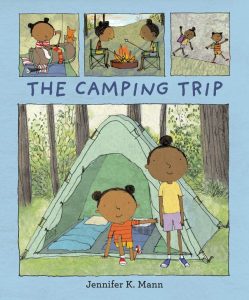 The Camping Trip
The Camping Trip
Written and illustrated by Jennifer K. Mann
Candlewick, 2020, 48 pp
ISBN: 978-1536207361
To prepare for her first camping trip in the forest, a young Black girl and her father practice making a tent with a blanket in her bedroom the night before the big adventure. Ernestine is going camping with Aunt Jackie and her cousin Samantha. Aunt Jackie sends her a list of things to pack: towel, camera, bandages, swimsuit, and flashlight. Ernestine is hesitant but also excited, and determined to love the experience. The first thing they do after arriving at Cedar Tree Campground is set up the tent. Then, they go swimming in the lake and Ernestine reminds herself that she enjoys swimming in the Y pool; however, seeing the fish in the lake makes her rethink the idea of swimming. When they decide to go hiking, Ernestine remembers that she walks to school every day, so hiking must be like walking–only in nature–but hiking the hills wears her out. Throughout the day, Ernestine, Aunt Jackie, and Samantha explore the forest. They make s’mores and read comic books before going to bed. But Ernestine can’t sleep and when she tries calling her father, the call does not go through because there is no reception in the forest. Aunt Jackie invites the children to look at the stars and make wishes upon a shooting star. The next morning the children eat pancakes, swim in the lake, then say goodbye to their camping site. At home, Dad is waiting for Ernestine with his arms wide open.
This story captures the hesitation and fear that most individuals experience when facing a new situation. Ernestine aims to make connections to familiar experiences but quickly notices that while there are similarities, there are also important differences across experiences. Ernestine is not alone in this process. Aunt Jackie, Samantha, and Dad support Ernestine before, during, and after the camping trip, sending the message that new experiences may require both personal willingness and external support.
Something that sets this story apart from others is the significance of the father-daughter relationship and the importance of family like aunts and cousins in the lives of young children. The text and the illustrations suggest that these relationships are based on a deep sense of caring and trust that allows Ernestine to feel love and safe enough to explore new places and activities. This book challenges existing dominant narratives in the field of children’s literature that still fail to capture diversity within family structures and dynamics. This hybrid picturebook/comic also contributes a positive depiction of families of color enjoying life to balance the numerous stories about social issues experienced by these cultural communities. While absolutely important, stories addressing struggles must be balanced with stories of happy everyday experiences to create a more authentic representation of life.
Mann created the illustrations using pencil on tracing paper, followed by a digital process of collage and painting. The illustrations combine double-page spreads and the use of graphic-style panels to highlight interesting sequences, like Ernestine gradually walking up the hill or the struggles she faces when trying to fall asleep. The story also relies on speech bubbles to convey both the conversations between the characters, and labels of exciting objects, such as the graham crackers and the marshmallow-roasting fork. The endpapers showcase drawing or camping items, with their labels, over a bright orange background. Readers can have fun finding the items throughout the story and/or brainstorming other objects they might take camping. Overall, the illustrations offer extensive details that work alongside the written text to create Ernestine’s world.
The Camping Trip could be paired with other picturebooks around camping in the forest like Fatima’s Great Outdoors, by Ambreen Tariq and Stevie Lewis (2021) or the wonderful visual narrative Flashlight, by Lizi Boyd (2014). Other pairing opportunities could highlight the father-daughter relationship like My Papi Has a Motorcycle, by Isabel Quintero and Zeke Peña (2019) or Hair Twins, by Raakhee Mirchandani and Holly Hatam (2021). Moreover, The Camping Trip could be read alongside stories that focus on aunt-niece relationships. For example, Tía Isa Wants a Car, by Meg Medina and Claudio Muñoz (2016) or Auntie Luce’s Talking Paintings, by Francie Latour and Ken Daley (2018).
Author and illustrator Jennifer K. Mann lives near Seattle and wrote this story inspired by her own camping experiences. As explained on the book jacket, Mann camps with her family and friends every summer “on the same campsite, at the same campground, in the same beautiful state park.” Her work can be explored at http://www.jenniferkmann.com/
María V. Acevedo-Aquino, Texas A&M-San Antonio
© 2022 by María V. Acevedo-Aquino

WOW Review, Volume XV, Issue 1 by Worlds of Words is licensed under a Creative Commons Attribution-NonCommercial-ShareAlike 4.0 International License. Based on work by María V. Acevedo-Aquino at https://wowlit.org/on-line-publications/review/xv-1/4
WOW review: reading across cultures
ISSN 2577-0527
